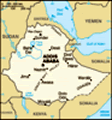Advertisement
Published: June 16th 2017
Geo: 12.6, 37.4667
This entry will actually cover the last few days. First, thanks everyone for all the birthday wishes and the Christmas greetings. Even though Ethiopians don't celebrate Christmas (Leddet) until January 6/7, many children and some adults wished us Merry Christmas as we were walking around the last couple of days.
Dec. 24 was spent getting to Gondar - via the usual local mini bus transport. Always an interesting experience but this trip was relatively uneventful - no flat tires, no need to change transport to a beer truck etc. Our young guide arranged even arranged for the van to pick us up at the hotel although we did make a stop at the bus station where there was much haggling and scouting for more people going to Gondar. We were finally on the road and the drive here is quite beautiful. Gondar is closer to the Simien Mountains so we gained a bit of altitude coming here. The road was windy but paved all the way with only the occasional break in the road or huge transport truck broken down exactly on a blind curve!
Our trekking guide, Alex, met us at our hotel here and we discussed plans for
our 3 days in the mountains. We will do that Mon-Wed coming up. In the meantime we have been exploring Gondar and learning about the area.
Gondar is a lovely (Ethiopian standards) city situated in the foothills of the Simien Mountains. It is an ancient city initially established as the capital of Ethiopia by King Fasilidas in the 1700's. He built a fabulous castle here which is right in the center of town. This gives the city a different feel than where we have been so far. The castle walls are quite easy to see from many parts of town and the town itself shows the most Italian influence with a 'piazza' and somewhat green boulevards. Some of the buildings are trimmed or painted in very bright blues, greens and yellows and they stand out in brilliant contrast to the overall dirt and shabbiness that is essentially Ethiopia. The people are once again incredibily friendly and we have had a minimum of beggars or small children asking for money.
Yesterday (25th) we visited the castle complex which covers 17,000 sq. meters and includes the main castle, a sauna and bath house and records building built by Fasiladas and then several

 Gouder Wine
Gouder Wine
Served in recycled beer bottles and dressed up in a cute little hat and wrap.other smaller castles built by two of his sons who succeeded him. There is also a lovely small castle built by the wife of one of these sons who apparently nursed him back to health and she was so incredibily beautiful that he married her. There are a couple versions of this story - both are fun and it would be interesting to know the real history of this woman. She actually ruled for a long while after her husband died because her son was just a baby. She built a school for woman to teach them how to not be so dependent on men! Keep in mind this is the 1700's - very cool lady.
Fasiladas also built a large pool in another part of town, now called Fasiladas baths which you visit on the same ticket you buy for the castle compound. The pool is huge - supposedly bigger than an olympic sized pool and the bath house is in the center. This is still used once a year for Ethiopian Epiphany (Timket) which is in the second half of January. This is the most important religious festival in Ethiopia and Gondar's population will swell by 10,000 visitors to
take part in the festivities which include bathing in this pool. Richard will be in Ethiopia for this but he will be in Addis Ababa. Everyone here says this is the best place and I am sure it is but it would be virtually impossible to get a room for it now.
Today is the main local market day so, of course, that is where we headed to this morning. It is loud, dirty, incredible chaotic and SO much fun!!! We had a young tout (street guide) and his friend lead us to and around the market. As a result we got to see 'behind the scenes' of many of the stalls and 'talk' to the sellers.
So, here is the factoid of the day: A very small population of Jews still remain in Ethiopia today living in a small village area about 5 km from Gondar. They are called Falasha's. They are different from Jews anywhere in the world - do you know why? (Hint - it is not because they are black).
Tomorrow we are going bird watching on the other end of Lake Tana at a place called Gongora.
Advertisement
Tot: 0.126s; Tpl: 0.014s; cc: 5; qc: 46; dbt: 0.0499s; 1; m:domysql w:travelblog (10.17.0.13); sld: 1;
; mem: 1.2mb


























tric Syz
non-member comment
Here is my guess about what makes the Falasha Jews different.... is it because they didn't read scriptures in Hebrew, or is that they practiced circumcision, but it was performed by a woman? Was just doing some reading about them and found
their evolution very interesting. I've never even heard of Falash Jewish people before.